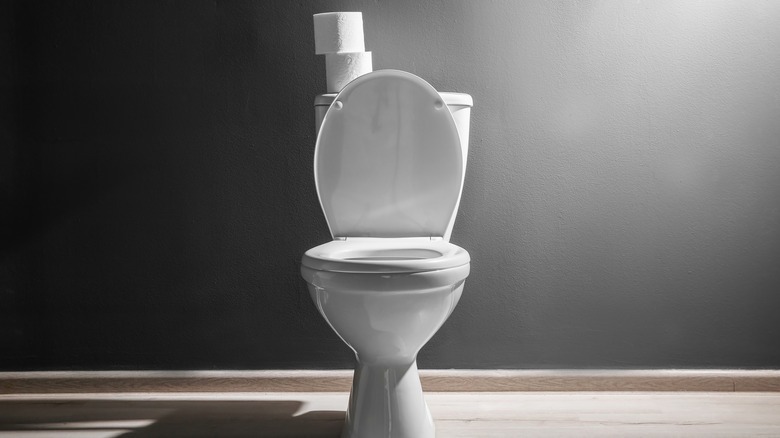Pour Vinegar Into Your Toilet And See What Happens
Toilets can get gross. This isn't too surprising considering what goes into them. Hard water stains (which are caused by a buildup of minerals in water) can also contribute to the mess. If your toilet is looking particularly grimy, and no amount of scrubbing is getting rid of stains, you're probably wondering what you should do. How do you get your toilet looking clean and sparkling again? Should you buy expensive cleaning products? Do you need to call a plumber? Or maybe your toilet is simply stained beyond redemption and it's time to just call it quits and replace your toilet with a new one.
Fortunately, there's a pretty easy solution that many people don't know about: vinegar. You likely already have a bottle of vinegar in your kitchen, and this acidic substance is just what you need to keep your toilet clean. Vinegar is quite the effective cleaning tool. If you're still skeptical, here's the science behind why vinegar is the perfect toilet cleaner.
According to The Kitchn, vinegar is made from a fermentation process. You probably know that wine needs to go through this process, which causes sugar to turn to alcohol. After a bottle is uncorked, though, wine continues to ferment, gradually converting alcohol into vinegar's main compound, acetic acid. This compound is what makes vinegar so acidic — distilled white vinegar has a pH of 2.4. This pH level means that vinegar can break down not just hard water stains, but also soap scum and sticker residue, among other stains. Combined with baking soda, vinegar can actually dissolve red wine stains, even after they have already set. Talk about a magic substance.
There are even some who will take things one step further and use vinegar as a disinfectant, although the Centers for Disease Control and Prevention notes that it is ineffective against some pathogens. You also need to be careful as vinegar's high acidity means that it can create stains of its own if you use it on delicate fabrics.
Suffice it to say, vinegar is powerful. While there are products on the market that claim to effectively clean your toilet, vinegar is much simpler — not to mention cheaper. Vinegar is also a good choice for people who like to avoid using unnecessary chemicals and want to keep things green.
All you need to clean your toilet tank is a heated mixture of 9 percent vinegar and baking soda, according to the YouTube channel Bright Side. For 7 ounces of heated vinegar, this means you need 1 tablespoon of baking soda. Alternatively, you could use an iodine solution, in which case you want to use equal parts iodine and vinegar. Make sure you're using white vinegar, though, as apple cider vinegar can leave stains.
It really is that simple! Once you've got your solution made and you're ready to start cleaning, all you need to do is pour it into your toilet's tank. From there, just let the vinegar solution break down all the nasty stuff lurking there for several hours (it's best to do this overnight, or when no one will be home for a few hours). Flush away the solution after it works its magic, and voila! You have a clean toilet. If your toilet still isn't quite as clean as you'd like, you can repeat the process.
What if you're looking to clean your toilet bowl and not your toilet tank? Again, vinegar can come to the rescue, says the blog Get Green Be Well. To clean your toilet bowl, put some vinegar in a spray bottle and spray it around the bowl. Let it sit for at least 10 minutes. You should then find it pretty easy to scrub away stains with a toilet brush. You can also pour vinegar directly into the bowl if it's really nasty. Vinegar can be particularly helpful if you have a toilet ring circling your bowl.
Once your toilet is nice and shiny, you just might find yourself on a cleaning kick. To clean your bathroom mirrors as well as floors, counters, cabinets, and soap scum buildup in the shower, the blog Wellness Mama recommends using a solution made of 50 percent vinegar and 50 percent water. Just spray it onto the surfaces that need cleaning and then wipe them dry.
Who knew that a simple liquid that is already found in many households would prove to be such an effective cleaning product?
